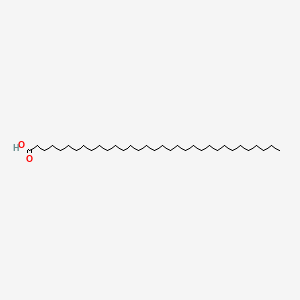| MeSH term | MeSH ID | Detail |
|---|---|---|
| Diabetes Mellitus, Type 2 | D003924 | 87 associated lipids |
| Body Weight | D001835 | 333 associated lipids |
| Hypercholesterolemia | D006937 | 91 associated lipids |
tritriacontanoic acid
tritriacontanoic acid is a lipid of Fatty Acyls (FA) class. Tritriacontanoic acid is associated with abnormalities such as hypercholesterolemia, Metabolic syndrome, Diabetes Mellitus, Non-Insulin-Dependent, Diabetes Mellitus, Insulin-Dependent and Parkinson Disease. The involved functions are known as Fermentation, Process, Longterm Effects, Pressure- physical agent and Lipid Metabolism. Tritriacontanoic acid often locates in Blood, Tissue fiber and A Fibers. The associated genes with tritriacontanoic acid are STN gene. The related lipids are Total cholesterol and blood lipid.
Cross Reference
Introduction
To understand associated biological information of tritriacontanoic acid, we collected biological information of abnormalities, associated pathways, cellular/molecular locations, biological functions, related genes/proteins, lipids and common seen animal/experimental models with organized paragraphs from literatures.
What diseases are associated with tritriacontanoic acid?
tritriacontanoic acid is suspected in hypercholesterolemia, Metabolic syndrome, Diabetes Mellitus, Non-Insulin-Dependent, Diabetes Mellitus, Insulin-Dependent, Parkinson Disease and other diseases in descending order of the highest number of associated sentences.
Related references are mostly published in these journals:
| Disease | Cross reference | Weighted score | Related literature |
|---|
Possible diseases from mapped MeSH terms on references
We collected disease MeSH terms mapped to the references associated with tritriacontanoic acid
PubChem Associated disorders and diseases
What pathways are associated with tritriacontanoic acid
There are no associated biomedical information in the current reference collection.
PubChem Biomolecular Interactions and Pathways
Link to PubChem Biomolecular Interactions and PathwaysWhat cellular locations are associated with tritriacontanoic acid?
Visualization in cellular structure
Associated locations are in red color. Not associated locations are in black.
Related references are published most in these journals:
| Location | Cross reference | Weighted score | Related literatures |
|---|
What functions are associated with tritriacontanoic acid?
Related references are published most in these journals:
| Function | Cross reference | Weighted score | Related literatures |
|---|
What lipids are associated with tritriacontanoic acid?
Related references are published most in these journals:
| Lipid concept | Cross reference | Weighted score | Related literatures |
|---|
What genes are associated with tritriacontanoic acid?
Related references are published most in these journals:
| Gene | Cross reference | Weighted score | Related literatures |
|---|
What common seen animal models are associated with tritriacontanoic acid?
There are no associated biomedical information in the current reference collection.
NCBI Entrez Crosslinks
All references with tritriacontanoic acid
Download all related citations| Authors | Title | Published | Journal | PubMed Link |
|---|---|---|---|---|
| Anderson JW et al. | Cholesterol-lowering effects of psyllium hydrophilic mucilloid for hypercholesterolemic men. | 1988 | Arch. Intern. Med. | pmid:3277558 |
| Abraham ZD and Mehta T | Three-week psyllium-husk supplementation: effect on plasma cholesterol concentrations, fecal steroid excretion, and carbohydrate absorption in men. | 1988 | Am. J. Clin. Nutr. | pmid:2827455 |
| Bell LP et al. | Cholesterol-lowering effects of psyllium hydrophilic mucilloid. Adjunct therapy to a prudent diet for patients with mild to moderate hypercholesterolemia. | 1989 | JAMA | pmid:2724486 |
| Miettinen TA and Tarpila S | Serum lipids and cholesterol metabolism during guar gum, plantago ovata and high fibre treatments. | 1989 | Clin. Chim. Acta | pmid:2553302 |
| Watters K and Blaisdell P | Reduction of glycemic and lipid levels in db/db diabetic mice by psyllium plant fiber. | 1989 | Diabetes | pmid:2555240 |
| Schneider RP | Perdiem causes esophageal impaction and bezoars. | 1989 | South. Med. J. | pmid:2814636 |
| Schwartz HJ et al. | Occupational allergic rhinitis reaction to psyllium. | 1989 | J Occup Med | pmid:2769459 |
| Costa MA et al. | Effects of dietary cellulose, psyllium husk and cholesterol level on fecal and colonic microbial metabolism in monkeys. | 1989 | J. Nutr. | pmid:2547038 |
| Costa MA et al. | Effects of dietary cellulose and psyllium husk on monkey colonic microbial metabolism in continuous culture. | 1989 | J. Nutr. | pmid:2547037 |
| Khouri MR et al. | Sudan stain of fecal fat: new insight into an old test. | 1989 | Gastroenterology | pmid:2463205 |
